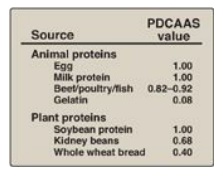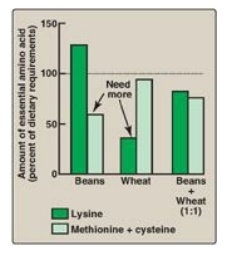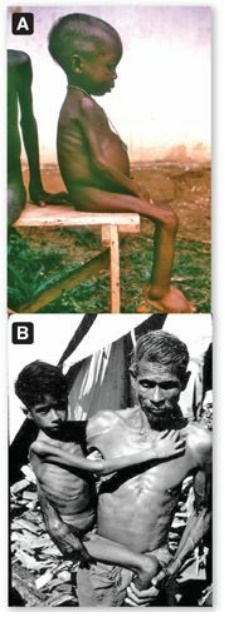Dietary Protein
| Home | | Biochemistry |Chapter: Biochemistry : Nutrition
Humans have no dietary requirement for protein per se, but the protein in food does provide essential amino acids.
DIETARY PROTEIN
Humans have no dietary
requirement for protein per se, but the protein in food does provide essential
amino acids (see Figure 20.2). Nine of the 20 amino acids needed for the
synthesis of body proteins are essential (that is, they cannot be synthesized
in humans).
A. Quality of proteins
The quality of a
dietary protein is a measure of its ability to provide the essential amino
acids required for tissue maintenance. Most government agencies have adopted
the Protein Digestibility–Corrected Amino Acid Score (PDCAAS) as the standard
by which to evaluate protein quality. PDCAAS is based on the profile of
essential amino acids after correcting for the digestibility of the protein.
The highest possible score under these guidelines is 1.00. This amino acid
score provides a method to balance intakes of poorer-quality proteins with
high-quality dietary proteins.
1. Proteins from animal sources: Proteins from animal sources
(meat, poultry, milk, and fish) have a high quality because they contain all
the essential amino acids in proportions similar to those required for
synthesis of human tissue proteins (Figure 27.19), and they are more readily
digested. [Note: Gelatin prepared from animal collagen is an exception. It has
a low biologic value as a result of deficiencies in several essential amino
acids.]

Figure 27.19 Relative quality of some common dietary proteins. PDCAAS = protein digestibility-corrected amino acid score.
2. Proteins from plant sources: Proteins from plant sources have a lower quality than do animal proteins. However, proteins from different plant sources may be combined in such a way that the result is equivalent in nutritional value to animal protein. For example, wheat (lysine deficient but methionine rich) may be combined with kidney beans (methionine poor but lysine rich) to produce an improved biologic value. Therefore, eating foods with different amino acids during the day can result in a dietary combination with a higher biologic value than either of the component proteins (Figure 27.20 ). [Note: Animal proteins can also complement the biologic value of plant proteins.]

Figure 27.20 Combining two incomplete proteins that have complementary amino acid deficiencies results in a mixture with a higher biologic value.
B. Nitrogen balance
Nitrogen balance occurs
when the amount of nitrogen consumed equals that of the nitrogen excreted in
the urine (primarily as urinary urea nitrogen, or UUN), sweat, and feces. Most
healthy adults are normally in nitrogen balance.
1. Positive nitrogen balance: This occurs when nitrogen intake
exceeds nitrogen excretion. It is observed during situations in which tissue
growth occurs, for example, in childhood, pregnancy, or during recovery from an
emaciating illness.
2. Negative nitrogen balance: This occurs when nitrogen loss is
greater than nitrogen intake. It is associated with inadequate dietary protein;
lack of an essential amino acid; or during physiologic stresses, such as
trauma, burns, illness, or surgery.
Nitrogen (N) balance can be determined by the formula, N balance = protein N intake (g/24 hrs) – (UUN + 4 g), where 4 g accounts for urinary loss in forms other than UUN plus loss in skin and feces. Alternatively, protein balance = protein intake (g/24 hrs) – [(UUN + 4 g) x 6.25] can be used because there are, on average, 6.25 g N in 1 g protein.
C. Requirement for protein in humans
The amount of dietary
protein required in the diet varies with its biologic value. The greater the
proportion of animal protein included in the diet, the less protein is
required. The RDA for protein is computed for proteins of mixed biologic value
at 0.8 g/kg of body weight for adults, or about 56 g of protein for a 70-kg
individual. People who exercise strenuously on a regular basis may benefit from
extra protein to maintain muscle mass, and a daily intake of about 1 g/kg has
been recommended for athletes. Women who are pregnant or lactating require up
to 30 g/day in addition to their basal requirements. To support growth, infants
should consume 2 g/kg/day.
1. Consumption of excess protein: There is no physiologic advantage
to the consumption of more protein than the RDA. Protein consumed in excess of
the body’s needs is deaminated, and the resulting carbon skeletons are
metabolized to provide energy or acetyl coenzyme A for fatty acid synthesis.
When excess protein is eliminated from the body as urinary nitrogen, it is
often accompanied by increased urinary calcium, thereby increasing the risk of
nephrolithiasis and osteoporosis.
2. The protein-sparing effect of carbohydrate: The dietary protein requirement is influenced by the carbohydrate content of the diet. When the intake of carbohydrates is low, amino acids are deaminated to provide carbon skeletons for the synthesis of glucose that is needed as a fuel by the central nervous system. If carbohydrate intake is less than 130 g/day, substantial amounts of protein are metabolized to provide precursors for gluconeogenesis. Therefore, carbohydrate is considered to be “protein-sparing,” because it allows amino acids to be used for repair and maintenance of tissue protein rather than for gluconeogenesis.
D. Protein-energy (calorie) malnutrition
In developed countries,
protein-energy malnutrition (PEM) is most commonly seen in patients with
medical conditions that decrease appetite or alter how nutrients are digested
or absorbed or in hospitalized patients with major trauma or infections. [Note:
Such highly catabolic patients frequently require intravenous (parenteral) or
tube-based (enteral) administration of nutrients.] PEM may also be seen in children
or the elderly who are malnourished. In developing countries, an inadequate
intake of protein and/or energy is the primary cause of PEM. Affected
individuals show a variety of symptoms, including a depressed immune system
with a reduced ability to resist infection. Death from secondary infection is
common. PEM is a spectrum of degrees of malnutrition, and two extreme forms are
kwashiorkor and marasmus (Figure 27.21 ). [Note: PEM is also referred to as
protein-energy undernutrition (PEU).]

Figure 27.21 Features of protein-energy malnutrition in children.
1. Kwashiorkor: Kwashiorkor occurs when protein deprivation is
relatively greater than the reduction in total calories. Protein deprivation is
associated with severely decreased synthesis of visceral protein. Kwashiorkor
is commonly seen in developing countries in children after weaning at about age
1 year, when their diet consists predominantly of carbohydrates. Typical
symptoms include stunted growth, skin lesions, depigmented hair, anorexia,
enlarged fatty liver, edema, and decreased serum albumin concentration. Edema
results from the lack of adequate blood proteins, primarily albumin, to
maintain the distribution of water between blood and tissues. It may mask
muscle loss. Therefore, chronic malnutrition is reflected in the level of serum
albumin. [Note: Because caloric intake from carbohydrates may be adequate,
insulin levels suppress lipolysis and proteolysis. Kwashiorkor is nonadapted
malnutrition.]
Cachexia, a wasting disorder characterized by loss of appetite and muscle atrophy (with or without increased lipolysis) that cannot be reversed by conventional nutritional support, is seen with a number of chronic diseases, such as cancer and chronic pulmonary and renal disease. It is associated with decreased treatment tolerance and response and decreased survival time.
2. Marasmus: Marasmus occurs when calorie deprivation is
relatively greater than the reduction in protein. It usually occurs in developing
countries in children younger than age 1 year when breast milk is supplemented
with watery gruels of native cereals that are usually deficient in both protein
and calories. Typical symptoms include arrested growth, extreme muscle wasting
and loss of subcutaneous fat (emaciation), weakness, and anemia (Figure 27.22
). Individuals with marasmus do not show the edema observed in kwashiorkor.

Figure 27.22 A. Listless child with kwashiorkor. Note the swollen belly. B. Child suffering with marasmus.
Related Topics
